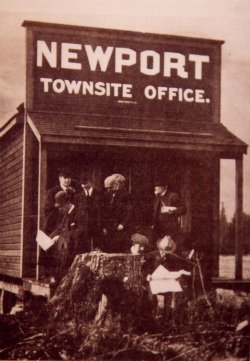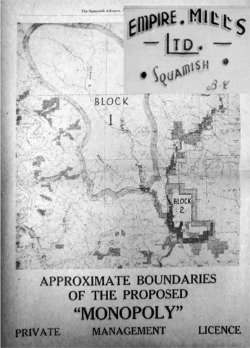 By Eric Andersen
By Eric Andersen
Published: Feb. 18, 2012
“Squamish is not a ‘PROJECT’, like Whistler is. It’s grown more organically, according to the resources and opportunities available to the people living here.”
This was the observation of my curling team skip, over beers at the club recently. He who spoke these words is a wise man, with unique expertise and Squamish ‘old-timer’ family perspective.
 However, it is also true that there have been several attempts to make a Grand Project out of Squamish – the ‘Head of Howe Sound’.
However, it is also true that there have been several attempts to make a Grand Project out of Squamish – the ‘Head of Howe Sound’.
Going back some thousands of years, this valley at the head of the fjord may have been seen as a project by the tribe of the Salish people today known by the name they gave to the river. Maybe there were Grand Projects concerning Squamish then too – perhaps military in nature, relating to defence or conquest.
The Squamish and Cheakamus rivers are the route of an ancient ‘Grease Trail’ between the Coastal and Interior Salish peoples. At least since the Gold Rush times, making a project out of Squamish has usually involved schemes to develop its potential as a ‘Gateway’ or ‘Portal’ for this strategic coast-interior travel and trade route through the mountains.
During the 1870s, this corridor was surveyed for the Canadian Pacific Railway, and the ‘Head of Howe Sound’ seriously proposed as potential transcontinental railway terminus.
This led to speculative interest in the Squamish River delta. An investment syndicate led by Burrard Inlet sawmiller Sewell P. Moody were the first pre-emptors of land here – for cattle ranching purposes, so they claimed. But they surely had bigger ideas!
Big dreams. Speculative investments. The Squamish River delta. Boom and …bust. These are recurring themes through the various chapters of the Squamish Project.
Thirty years later, from 1907, the Newport investors again conceived another Grand Project for Squamish. They took care to quietly assemble as much delta land as possible, before announcing their scheme to the world in advertisement campaigns: “BUY IN NEWPORT NOW! …Its position on the trade routes of British Columbia is so unique, and the resources tributary to it are so enormous …The time to make money is at the beginning of things!”
Squamish Project hopes and plans have often been quite genuine and sincere, even when the outcomes have been disappointments – or disasters. Two Squamish Project schemes – quite literally – went down in shipwrecks!
The history of Squamish can be, and often is summed up by referring to these various schemes over the last century and more – understandably. Some of the attempts at making a Grand Project out of Squamish have had decisive, lasting impacts on the community.
Our transportation infrastructure and the physical layout of our community are mostly the legacy of these past project schemes.
In between these Grand Projects, however, there has also been community reflection and debate. Do we want Squamish to be a ‘Project’ – of outside schemers and capitalists?
During one such period of community reflection, before the anticipated ‘boom’ that would surely follow the completion of a road to Vancouver, Squamish Board of Trade director and local druggist Bernard Brown offered some thoughts, interesting today:
“We don’t want a boom here. I have heard of too many places in somewhat similar circumstances that literally ached for a boom.
 Those who were most anxious to see new homes and new streets and additional business houses, overlooked the very obvious fact that every boom must have its bust.
Those who were most anxious to see new homes and new streets and additional business houses, overlooked the very obvious fact that every boom must have its bust.
“This village can grow and develop slowly and give to every resident a sense of pride and a real feeling of security.
“We may never be a big town but we can be a good little town and I am convinced we have far more to gain by a slow and constructive growth than we can hope to realize by an overnight boom.”
(“Squamish Businessmen Want Steady, Constructive Growth” – The Squamish Review, August 9, 1949)
A series of upcoming articles in the Squamish Reporter will review several Squamish Project schemes of the past 150 years or so, and their stories.
Squamish Projects to be discussed will include: the C.P.R. survey and the Moodyville Syndicate; Walter Moberly and his electric railway scheme; the Howe Sound & Northern Ry and Newport; the P.G.E.; the 1950s Empire Mills Ltd. quest for a Forest Management Licence; and the Squamish Oceanfront.
This year, 2012, it is one hundred years since both the founding of the Pacific Great Eastern Railway and the RMS Titanic disaster. The next installment will discuss how the Squamish Project of the P.G.E. Ry and the Titanic disaster are linked, and the local effects of the world’s most famous shipwreck.



An interesting article, Eric. I’m looking forward to the next.
great job Eric it is always a experiance to read your articals.looking forward to the next
Eric… good article and foresight… but do not loose the reasoning, no one was trying to make Squamish or Newport a better community to raise a family before the 50’s … it was all about sustaining or bettering ones families lifestyle and taking advantage of the inherent possibilies, if there was anything left over be prepared to fight for it. Always remember my childhood in Shalalth, where my mother spent most of her time (first female settler) informing the first nation people about their ancestors, because all they had were stories of grandure and other fictious stoies of the past, but no records to support the stories. Your are doing a great job of bringing that support of our past, but we still have to be realistic. Cheers DP